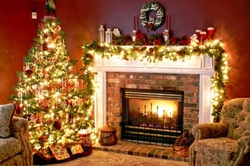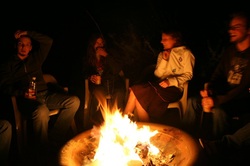|
Circa 1994 The heat of a fire starts with a match. The best matches are the wooden kitchen variety, or long fireplace matches. Wooden matches burn more slowly allowing you to place the flame carefully and accurately. Three types of fuel are used - tinder, kindling, and logs. Tinder is highly flammable and is the first ingredient to catch fire. Good tinder includes uncolored newspaper, brown bags, wood chips, and the tips of dead pine branches. Next in line is kindling. Kindling is slower to ignite, but when it does catch, it burns long enough to set the logs on fire. The best logs come from dense, strong deciduous trees called hardwoods. Hardwoods include oak, maple, ash, beech and birch. Fruit and nut trees such as cherry, pear, and pecan are hardwoods that burn well and emit a wonderful fragrance. Softwoods such as pines and spruces are easier to ignite that hardwoods. They contain resin which is an extremely flammable substance. By burning these resinous logs, you would have to stoke the fire constantly. Resin, also, never burns completely and pollutes the aire while collecting on chimney walls forning creosote. If enough creosote buildup occurs, balls of fire could come shooting into your room or onto the roof. Freshly cut wood is "green" or full of water, which makes it burn unevenly - hissing, squeaking and spewing smoke. Burning dry wood produces less smoke and ash. It takes six months to a year to dry wood properly. If you observe tiny radial cracks along the cross-sectioned surfaces, the wood is dried correctly. Air must be present in the fire's assemblage. Build a structure of kindling and tinder that is compact enough for the flame to move from piece to piece, but loose enough that there is air space throughout it. Since fire burns upward, larger kindling should always be placed above the smaller bits, so that it catches fire from them. With proper materials and techniques you can make your fire las throughout the long Indiana winter. So, wrap up in a warm quilt and enjoy the roar of a sizzling fire! A fire in the hearth can take away the stresses of a busy day and fill your weary body with an inner heat from head to toe. Building a crackling fire is a work of art with the right materials and technigues.
Three things are needed to create a perfect fire - fuel to burn, oxygen and heat. These three components must be balanced. Too much of one element might extinguish flames. Too much of another element and you'll be calling the fire department.
0 Comments
Leave a Reply. |
AuthorsCurrent and former staff members have contributed to our newsletter over the years. Now the articles are available to view here on our blog Categories
All
|
© 2024 Ski Landscape Corporation - Website by Day Design



 RSS Feed
RSS Feed